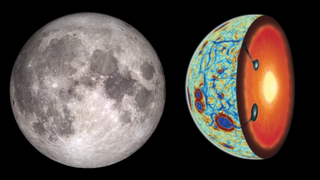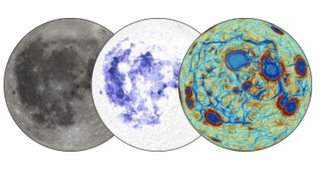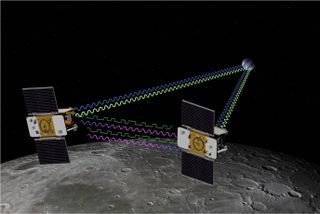What happened when the moon 'turned itself inside out' billions of years ago?
"For the first time, we have physical evidence showing us what was happening in the moon's interior during this critical stage of its evolution, and that's really exciting."

Over 4.2 billion years ago, the moon turned itself inside out to create the lunar surface that has become familiar to humanity.
Most scientists would agree the moon was created around 4.5 billion years ago, when another massive body in the solar system smashed into Earth, flinging molten material into space that coalesced as our natural satellite.
How the birth of the moon proceeded after this violent start, however, has been described as "more of a choose-your-own-adventure novel" by a team of scientists from the University of Arizona's Lunar and Planetary Laboratory (LPL).
They say there are many possible paths Earth's natural satellite could have taken to form in full, ultimately leading to the moon-Earth system we see today. The team of course has its own ideas about the major incidences that might have formed the moon. The researchers say rock samples collected during the Apollo mission, for instance, may indicate there was a time when the moon "flipped inside out."
This result, if true, might also solve a lingering mystery about the moon's composition.
Related: A chunk of the 'protoplanet' that made the moon may be stuck near Earth's core
"Our moon literally turned itself inside out," research co-author and LPL associate professor Jeff Andrews-Hanna said in a statement. "But there has been little physical evidence to shed light on the exact sequence of events during this critical phase of lunar history, and there is a lot of disagreement in the details of what went down — literally."
Get the Space.com Newsletter
Breaking space news, the latest updates on rocket launches, skywatching events and more!
Titanium on the near side of the moon?
Basaltic lava rocks brought back from the moon have shown surprisingly high concentrations of titanium. In addition to this, satellite observations have revealed that titanium-rich volcanic rocks are primarily located at the lunar nearside. This left scientists scratching their heads about how these particular rocks got there and aren't more widely dispersed.
The University of Arizona team suggests the moon formed rapidly, leaving it entirely covered with a hot magma ocean at first. As this ocean cooled and hardened, it would have formed the outer layers of the moon, including its mantle and crust. Yet, at lower layers, the infant moon would have still been in turmoil.
Models of moon formation suggest the last remains of this giant lunar ocean crystallized into dense materials including ilmenite, a mineral rich in iron and titanium.
"Because these heavy minerals are denser than the mantle underneath, they create a gravitational instability, and you would expect this layer to sink deeper into the moon's interior," said research leader and former LPL doctoral candidate Weigang Liang, said.

Questions remain: Would this material sink all at once as a single "blob" after the moon solidified, or a little at a time as smaller blobs? And, if it sank within the interior of the moon on a global scale, how did some of it rise to carry titanium to the moon's nearside?
"Without evidence, you can pick your favorite model," researcher co-lead author and German Aerospace Center scientist Adrien Broquet said in the statement. "Each model holds profound implications for the geologic evolution of our moon."
Co-author and Peking University scientist Nan Zhang previously developed models that suggested a giant impact on the moon could have caused a dense layer of titanium-rich material beneath the crust to shift to its nearside. Once there, this material would have sunk, formed sheet-like slabs and cascaded to the interior of the moon, leaving a remnant beneath the crust in the form of intersecting bodies of dense titanium-rich deposits.
"When we saw those model predictions, it was like a lightbulb went on," Andrews-Hanna said. "We see the exact same pattern when we look at subtle variations in the moon’s gravity field, revealing a network of dense material lurking below the crust."
The GRAIL of moon formation models
To solidify its molten theories of titanium-rich ilmenite material and observations of the moon, the team turned to data surrounding lunar gravity anomalies detected by NASA's Gravity Recovery and Interior Laboratory (GRAIL) dual-spacecraft mission.
"Analyzing these variations in the moon's gravity field allowed us to peek under the moon's surface and see what lies beneath," Broque said.
This confirmed that GRAIL data conforms with ilmenite layer simulations.
Such confirmation also showed that gravity-field observations could be used to trace the distribution of ilmenite remnants left behind after a majority of the dense layer had sunk to the deep interior of the moon.
"Our analyses show that the models and data tell one remarkably consistent story," Liang said. "Ilmenite materials migrated to the nearside and sunk into the interior in sheet-like cascades, leaving behind a vestige that causes anomalies in the moon's gravity field, as seen by GRAIL."

The team was also able to determine when the moon flipped inside out. They say the interruption of gravity anomalies by large and ancient lunar impact basins indicates the ilmenite-rich layer sank prior to these impacts. This "cross-cutting" means the sinking event would have happened earlier than 4.22 billion years ago, indicating that the sinking could have triggered volcanism, which was seen at later times across the lunar surface.
This research also adds nuance to an interesting picture of the moon we see today. The overturn of the lunar mantle billions of years ago would have led to the creation of a dark region known as the Oceanus Procellarum region, as well as on the side of the moon close to Earth.
This area of the moon is lower in elevation and has a thinner crust that's mostly blanketed by lava flows unlike the thicker crust of far side regions of the moon. It also has a higher concentration of rare elements like titanium and thorium. "The moon is fundamentally lopsided in every respect," Andrews-Hanna said. "For the first time, we have physical evidence showing us what was happening in the moon's interior during this critical stage of its evolution, and that's really exciting.
"It turns out that the moon's earliest history is written below the surface, and it just took the right combination of models and data to unveil that story."
Broquet added: "The vestiges of early lunar evolution are present below the crust today, which is mesmerizing.
"Future missions, such as with a seismic network, would allow a better investigation of the geometry of these structures."
The findings could also help inform future investigations of our loyal lunar companions if and when, in 2025, NASA's Artemis III mission returns humanity to the moon for the first time since the Apollo missions drew to an end 50 years ago.
"When the Artemis astronauts eventually land on the moon to begin a new era of human exploration," Liang concluded. "We will have a very different understanding of our neighbor than we did when the Apollo astronauts first set foot on it."
The team's research is published in the journal Nature Geoscience.
Join our Space Forums to keep talking space on the latest missions, night sky and more! And if you have a news tip, correction or comment, let us know at: community@space.com.

Robert Lea is a science journalist in the U.K. whose articles have been published in Physics World, New Scientist, Astronomy Magazine, All About Space, Newsweek and ZME Science. He also writes about science communication for Elsevier and the European Journal of Physics. Rob holds a bachelor of science degree in physics and astronomy from the U.K.’s Open University. Follow him on Twitter @sciencef1rst.
-
billslugg Earth also turned itself inside out very early in its life. There was a lot of iron pieces mixed in with the molten rock. At one point a bunch of them over rode those on the other side of the planet, sank down and formed the iron core. This was a toroidal convection. It also gathered bits of floating crust on one side to form the first continent. That crust, over millions of years, held in the heat underneath it. The far side of the ball of molten rock had no continent, it lost heat to space much faster, got heavy and sank, overcoming the lighter rock under the small continent. The first convection took place 3.5B years ago and the main event transpired in about two weeks. Since then another dozen or so toroidal convections have occurred. Currently, the Atlantic is opening and the Pacific closing. I read all this years ago and can't cite any sources.Reply -
Torbjorn Larsson It’s possible that Moon took another one for Earth, though their earlier conference contribution has them propose the South Polar AitkenReply
(SPA) basin-forming impact as the culprit. “The estimated ages of Serenitatis and SPA of ~4.22 Ga and 4.25 Ga may bracket the overturn event.”
The latest root dating places the split between biology and geology at 4.4 billion years, so life survived a few crust busters – the SPA impactor leaving a 2500 km crater would fit that (~ 100 km impactor). Presumably they never got to the 300-400 km size needed to completely vaporize our ocean.
The dating is off by 1 billion years, since Earth had a global ocean (and life) about 4.4 billion years ago. The new dated phylogeny has the first realistic root dating since it pulled it back (by cross bracing) from the usual "as soon as possible" estimate of traditional tree root datings.billslugg said:The first convection took place 3.5B years ago and the main event transpired in about two weeks. -
billslugg Of course, off by a billion. It had to be in the first couple of hundred million years since nearly the entire Earth was molten.Reply
